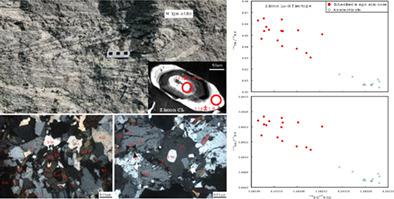当前位置:
X-MOL 学术
›
Geolog. J.
›
论文详情
Our official English website, www.x-mol.net, welcomes your feedback! (Note: you will need to create a separate account there.)
Anatexis of the deeply subducted continental crust during exhumation: A case study of Rongcheng migmatite in the Sulu orogen
Geological Journal ( IF 1.8 ) Pub Date : 2020-09-18 , DOI: 10.1002/gj.3986 Shaoji Yang 1 , Haijin Xu 1 , Pan Wang 1 , Junfeng Zhang 1 , Qiang Liu 1
Geological Journal ( IF 1.8 ) Pub Date : 2020-09-18 , DOI: 10.1002/gj.3986 Shaoji Yang 1 , Haijin Xu 1 , Pan Wang 1 , Junfeng Zhang 1 , Qiang Liu 1
Affiliation

|
Migmatite in the Sulu ultra‐highpressure (UHP) terrane is an ideal sample to provide information on anatexis during the exhumation of the deeply subducted continental crust. The studied migmatite is composed of the leucosome and melanosome with strongly ductile shear deformation. Petrographic observations clearly show an anatexis process, for example, cuspate and triangular K‐feldspars in triple junction and along grain boundaries, felsic veinlets and pockets mainly consisting of K‐feldspar + quartz + plagioclase ± biotite. The zircon grains of the migmatite have a core‐rim structure: the inherited magmatic core and the anatectic overgrowth rim. The inherited cores exhibit oscillatory zonings in the cathodoluminescence (CL) images and display strong heavy rare earth element (HREE) enrichment with clearly positive Ce and negative Eu anomalies. The inherited cores have an upper intercept U‐Pb age of 814 ± 45 Ma with εHf(t) values of −5.6 to ‐10.6 (mean = −8.5 ± 0.8, n = 16). Thus, protolith of the migmatite is a mid‐Neoproterozoic granitic rock. The overgrowth rims exhibit a typical anatexis genesis, that is, a bright homogeneous luminescence in the CL images, very low Th/U ratios (<0.02) with low U (<100 ppm) and Th (<1 ppm) contents, and lower total REE and Y contents with lower (Gd/Lu)N ratios and higher Hf/Y ratios than the inherited cores. They are Late Triassic with ages ranging from 211 to 234 Ma (mean = 223 ± 8 Ma), which, combined with previous studies on the Sulu UHP terrane, suggests that the anatexis occurred during the early exhumation stage. They have higher Ti‐in‐zircon temperatures ranging from 760 to 813°C (mean = 791 ± 16°C) than the pre‐anatexis zircon (244 ± 5 Ma and 739°C), suggesting a ‘hot’ exhumation. They have εHf(t) values of −17.6 to −14.5 (mean = −15.5 ± 0.6) which are lower than the estimated value (~12.0) on the crustal evolution array, suggesting an addition of crustal fluid during the anatexis. The anatexis also dramatically affected the zircon Lu–Hf isotopic system, that is, 176Yb/177Hf and 176Lu/177Hf isotopic ratios are markedly decreased but initial 176Hf/177Hf ratios are increased from the inherited magmatic cores to the anatectic rims. Thus, we propose that the anatexis plays a critical role in the exhumation of the UHP metamorphic rocks. The anatexis could lubricate the subducted slices and further facilitate their buoyant rise from the mantle depth to the crustal level.
中文翻译:

俯冲过程中深部俯冲大陆壳的反酸盐作用-以苏鲁造山带荣成蒙脱石为例
苏鲁超高压(UHP)地层中的蒙脱石是理想的样品,可在深俯冲的大陆壳发掘过程中提供有关食蚁兽的信息。所研究的蒙脱石由白质体和黑素体组成,具有强烈的韧性剪切变形。岩相学观测清楚地表明了一个麻醉过程,例如,在三重结合处和沿晶界的尖状和三角形钾长石,长丝脉和主要由钾长石+石英+斜长石±黑云母组成的矿穴。蒙脱石的锆石颗粒具有芯-边缘结构:继承的岩浆岩芯和食盐的过度生长边缘。继承的岩心在阴极发光(CL)图像中显示出振荡带,并显示出强烈的重稀土元素(HREE)富集,且Ce明显为正,Eu异常为负。ε的Hf(吨)的-5.6到-10.6值(平均值= -8.5±0.8,Ñ = 16)。因此,蒙脱石的原生岩是中新生代花岗岩。过度生长的边缘表现出典型的麻醉性成因,即CL图像中明亮的均匀发光,非常低的Th / U比(<0.02)和低的U(<100 ppm)和Th(<1 ppm)含量,以及更低的(Gd / Lu)N较低的总REE和Y含量比和比继承的核心更高的Hf / Y比。它们是晚三叠世,年龄在211至234 Ma(平均= 223±8 Ma)之间,再加上先前对Sulu UHP地层的研究表明,该食蚁动物发生在发掘早期。它们的钛锆石温度范围高于760到813°C(平均值= 791±16°C),而后者却低于前厌氧锆石(244±5 Ma和739°C),表明有“热”尸体。它们具有ε的Hf(吨的-17.6至-14.5)值(平均值= -15.5±0.6),它们比地壳演化阵列上的估计值(〜12.0)低,表明深熔期间的加成地壳的流体。麻醉剂还极大地影响了锆石的Lu–Hf同位素系统,即176 Yb / 177Hf和176路/ 177 Hf同位素比率显着降低,但初始176 HF / 177的Hf比率从继承岩浆核心对重熔边缘增加。因此,我们认为,食蚁动物在超高压变质岩的发掘中起关键作用。食盐动物可以润滑俯冲的薄片,并进一步促进它们从地幔深度到地壳水平的浮升。
更新日期:2020-09-18
中文翻译:

俯冲过程中深部俯冲大陆壳的反酸盐作用-以苏鲁造山带荣成蒙脱石为例
苏鲁超高压(UHP)地层中的蒙脱石是理想的样品,可在深俯冲的大陆壳发掘过程中提供有关食蚁兽的信息。所研究的蒙脱石由白质体和黑素体组成,具有强烈的韧性剪切变形。岩相学观测清楚地表明了一个麻醉过程,例如,在三重结合处和沿晶界的尖状和三角形钾长石,长丝脉和主要由钾长石+石英+斜长石±黑云母组成的矿穴。蒙脱石的锆石颗粒具有芯-边缘结构:继承的岩浆岩芯和食盐的过度生长边缘。继承的岩心在阴极发光(CL)图像中显示出振荡带,并显示出强烈的重稀土元素(HREE)富集,且Ce明显为正,Eu异常为负。ε的Hf(吨)的-5.6到-10.6值(平均值= -8.5±0.8,Ñ = 16)。因此,蒙脱石的原生岩是中新生代花岗岩。过度生长的边缘表现出典型的麻醉性成因,即CL图像中明亮的均匀发光,非常低的Th / U比(<0.02)和低的U(<100 ppm)和Th(<1 ppm)含量,以及更低的(Gd / Lu)N较低的总REE和Y含量比和比继承的核心更高的Hf / Y比。它们是晚三叠世,年龄在211至234 Ma(平均= 223±8 Ma)之间,再加上先前对Sulu UHP地层的研究表明,该食蚁动物发生在发掘早期。它们的钛锆石温度范围高于760到813°C(平均值= 791±16°C),而后者却低于前厌氧锆石(244±5 Ma和739°C),表明有“热”尸体。它们具有ε的Hf(吨的-17.6至-14.5)值(平均值= -15.5±0.6),它们比地壳演化阵列上的估计值(〜12.0)低,表明深熔期间的加成地壳的流体。麻醉剂还极大地影响了锆石的Lu–Hf同位素系统,即176 Yb / 177Hf和176路/ 177 Hf同位素比率显着降低,但初始176 HF / 177的Hf比率从继承岩浆核心对重熔边缘增加。因此,我们认为,食蚁动物在超高压变质岩的发掘中起关键作用。食盐动物可以润滑俯冲的薄片,并进一步促进它们从地幔深度到地壳水平的浮升。



























 京公网安备 11010802027423号
京公网安备 11010802027423号